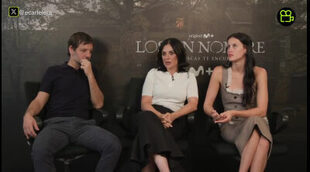Any film director (or actor, cameraman, writer or technician) has to be willing to go the distance, embarking on a months long project that results in a film that debuts in cinemas to be viewed by as many people as possible. Creating a film is a very long (and expensive) process and it is almost a miracle that anything reaches the cinema and that people get to see the fruit of such hard work.
For such a team that creates films, in many cases, it's worth all the effort and dedication to continue with the project despite the effort involved. But that's not always the case, sometimes the team isn't always convinced the effort was worth it. Sometimes a shoot can become a living hell. And if not, just ask the any of these 12 production teams. Some of these movies were indeed successful but others crashed and burned.
-

-

-

-

-

-

In virtually all shooting, it is implicit, that there will be unforeseen circumstances. There are some directors whom say they feel comfortable with those spontaneous situations, but sometimes these unexpected moments can ruin what could otherwise have been a good movie, and there are some unexpected events that even the best improvisor would find unfixable.
Here you have it, a collection of the 12 most disastrous films. There are more, for sure, but either by natural complications, discrepancies between the equipment or by legal proceedings, we believe these movies take the cake.

1 'Gladiator' (2000) $103,000,000
Mostly in this list, we have chosen a scenario where the production team had a plan and it went horribly wrong, however, in the case of 'Gladiator' it's totally different... Ridley Scott actually started shooting without any plan, and it actually went well.
When Scott started filming, he told the film's lead actor, Russel Crowe that they only had 21 pages of script (the standard measure in cinema is usually a page of script equals one minute of film). With only 21 pages, they could do little. Not letting that stop them however, the team flew to Morocco, chose the locations and recorded those 21 pages. There was even one day that Scott said to take the day off as the team had nothing to record. It was then that Russel Crowe, Scott and David Franzoni, one of the three writers of the film, began to write furiously. They even ended up writing and recording simultaneously, and even got the film finished in the original budget. Moreover, 'Gladiator' managed to win the Oscar for best picture. And raise 457 million dollars.

2 'The Wizard of Oz' (1939) $2,777,000
One of the greatest classics of film history, and also a film which could have suffered the most complications. It's widely known that 'The Wizard of Oz' had 5 different directors. Initially, Richard Thorpe was responsible for directing the film, but was fired after only twelve days because it was felt that he was giving it too much of a childish touch. Shortly after, George Cukor briefly took over whilst the producer, whom was another director, Mervin Leroy, was also fired. Then Victor Fleming took over, however Fleming left the shooting near the end to film 'Gone with the Wind'. King Vidor was commissioned to finish shooting.
Directors leaving was not the only problem, since the rest of the filming was chock full of accidents, starting with Buddy Ebsen, who played the Tin Man, whom began to feel cramps, itching and shortness of breath. It turns out that he was allergic to the makeup and actually ended up in hospital, so another actor, Jack Haley, had to take over his role. Margaret Hamilton, who played the Wicked Witch, also struggled with all the makeup, though her reaction was less severe, since all that happened was that she could not remove her make up and had to endure greenish skin several weeks after they had finished recording.
And the role of the Witch seemed to be cursed, since Betty Danko, Margaret Hamilton's double, also suffered a back injury when the dance director fell down a hole on top of her. She also broke a smoking pipe and accidentally made a deep cut on her leg, so they had to wait 11 extra days to film. The other actor whom brought trouble to the set was the dog Toto, whom was not trained and did whatever he wanted during filming.

3 'Waterworld' (1995) $175,000,000
Ever since 'Dances with Wolves' Kevin Costner has been an A-list Hollywood star. Then he decided to make 'Waterworld'.
At first it would seem to be a low budget film ($3 million), but by the end, it achieved a budget of $65 million. The production team opted to shoot in Hawaii without checking the conditions to see if was possible to do so, which they came to regret, as the sets were destroyed twice by hurricanes. The fact the sets where placed on sea was also a problem, due to the fact they had to be moved everyday 500 meters towards open sea. When someone on the team wanted to go to the bathroom he had to do it in a speedboat. Not to mention that the leading actresses almost drowned when she fell from a boat... It was chaos.
In all honesty it was chaos even before the shooting started. Up to 36 writers were tweaking the script, one of whom was Joss Whedon, whom has said his job was to give Kevin Costner what he pleased. In fact, it's said that Kevin Costner made shooting insufferable, because of, among other things, his constant bickering with director Kevin Reynolds (whom was actually chosen because he was a close friend of Kevin Costner, the studio wanted Robert Zemeckis) causing Kevin Reynolds to leave shortly before filming ended.
50 team members ended up sick in quickly built, prefabricated houses, whilst Costner lived in a villa that costed 4,500 euros a night.
However, the films was not a complete failure, and at the box office it actually managed to break even.

4 'Sorcerer' (1977) $22,000,000
William Friedkin came to reap two consecutive successes with 'The French Connection' and 'The Exorcist' before he decided to attempt a remake of the French 'The Wages of Fear' with 'Sorcerer' that, despite being far from a bad movie, was one of the least profitable films that has ever been made (perhaps this could have been influenced by the fact it was released a week after 'Star Wars')
The budget had to be stretched due to the complicated special effects that the director wanted to use, and because the shooting took place in several Latin American countries, mostly in the Dominican Republic, but, due to the location, upwards of 50 team members became ill with malaria and other tropical diseases. The scene that increased the budget of the film the most was one in which a truck had to pass over a bridge in poor conditions above a river. It cost the production team three months and a million dollars to build the bridge, just in time for the river to suddenly dry up. So that scene was finally filmed in Mexico (with the cost it takes to move to Mexico and build another bridge there)
The film finally went ahead to crash at the box office. Not coming close to raising the money it had cost to make with $9 million at the box office.

5 'Heaven's Gate' (1980) $44,000,000
Although the shooting itself was not as disastrous as some of the previous films in this list as far as complications are concerned, 'Heaven's Gate' is a film that we couldn't miss in this list, since it is a film that caused a self destruction of the career of it's director, Michael Cimino. It also involved the bankruptcy of studio United Artists, which for many years was the main precursor of the famous American Star System.
The main problem came from it's own director, Cimino, whom became successful with 'The Hunter', and the production company gave him total control of everything (big mistake). Camino wanted to film his masterpiece, and that led to an extreme perfectionism, so filming was proceeding at an excessively slow pace, repeating each shot about thirty times each. The initial budget accounted for recording roughly two pages of script daily for a total of 133 days. Well, Cimino recorded little more than a page a day on average, which caused them to be 12 days and 15 pages behind schedule. When filming, we understand that time is money, as the longer it takes, the more expensive the film will be, so the initial budget of the film was finished when there were still three quarters of the script left to film. When finally finished, the movie had a duration of three hours and thirty four minutes. After the premier, the reviews were not at all favorable, so United Artists canceled the premiere to remount the film and make it shorter. Finally, the duration was reduced to two hours. The final cost of 'Heaven's Gate' was $44 million however, it only grossed $1.3 million. No need to be a maths genius to see that the production company lost quite a lot of money. Metro Goldwyn Mayer eventually bought United Artists before it closed. But no producer again gave this much freedom to a director ever again.

6'Apocalypse Now' (1979) $31,500,000
It seems unthinkable today that 'Apocalypse Now' was one of the most chaotic film productions, because we're talking about one of the best war movies that's ever been made.
Originally a book by Joseph Conrad, the story was adapted by Francis Ford Coppola, and although the novel was set in Africa in the late nineteenth century, Coppola changed the location and time to the Vietnam War. But if he had known what was in store, he would have surely thrown the novel away without a second thought.
The first problem that Francis Ford Coppola and company had was the inability to roll in Vietnam, so the team had to move all the material to the Philippines... But soon after arriving there, typhoon Olga destroyed many of the sets.
Once settled, both director and its star were ready to roll. At first the film starred Harvey Keitel, but after a week and a half of filming, Coppola decided that the actor was not up to the role and dismissed him, which further delayed the shoot. The role was offered to five big name actors, but they all rejected them. Finally they had to settle for then unknown Martin Sheen... But this was only the start of the problems. The new protagonist didn't do well with the weather or the conditions of life in the jungle and fell ill with malaria, having to record sick. Martin Sheen went so far in the shooting that he even had a heart attack in the middle of recording, to which Coppola said: "Do not die until I tell you". This was not the only problem with the actors as Marlon Brando and Dennis Hopper could not stand each other, and refused to shoot together, so scenes they were both in had to be shot on different days. In addition to all this, the helicopters that attack the vietnamese village were provided by the Philippine army, so the crew had to be aware of when they could use them or not. Several times, without warning, the helicopters they had requested were suddenly confiscated. Finally the shooting lasted more than two years, which pushed up the budget to the extent where Francis Ford Coppola had to mortgage his house. Thankfully for him, the film did well.

7 'Cleopatra' (1963) $45,000,000
Many adaptations have been made on the life of 'Cleopatra', and many people still remember Elizabeth Taylor as the best Queen of the Nile, but this does not mean that their production wasn't one of the most disastrous in history.
At first the filming was going to be in London, but from the beginning it was said that the climate was nothing like Egypt. Finally they moved to Italy when Elizabeth Taylor came down with meningitis, and after a heavy cold that led to pneumonia. The actress even entered a coma. When she awoke she learned that the production team moved the set and that they had changed the main character with actor Richard Burton. The set had to be built again and redecorated in Rome. Also the hired extras kept stealing objects from the set.
From the beginning, the choice of director was very difficult. At first Rouben Mamoulian was chosen, but he left the project, unable to cope with the pressure, and so was replaced by Joseph L. Mankiewicz, who knew how to deal with actors and producers. One of the executive producers died of a heart attack (some say due to the stress he was under for this film). Although the director's work seemed to go well, the studio dismissed him in the middle of filming and hired Darry F. Zanuck.
The actors were also problematic as Richard Burton turned up to every shoot drunk and Elizabeth Taylor refused to shoot in the first three days of menstruation, made people bring her food from the US and asked for a raise almost at the beginning of the film.
There was also a hairdresser strike which delayed several days of filming. As if this were not enough, a court seized rolls of film by demand from a group of technicians who were dismissed. The production was so slow that some Italian productions took advantage of the sets for 'Cleopatra' for their own films. All this made the budget, which would've been 10 million dollars, 45 million dollars. It also ended up taking 4 years to film.

8 'Battlefield Earth' (2000) $73,000,000 + 'Sound of Thunder' (2005) $52,000,000
We know, we know, we know, these are 2 different movies, but we can't talk about one without talking about the other, for although the film shoots were not so chaotic, it is one of the biggest disasters economically speaking in the history of film, since 'Battlefield Earth' also ruined 'Sound of Thunder'.
It all starts, as with many other stories, with love. More specifically, John Travolta's love for the science fiction novel, 'Battlefield Earth' written by L. Ron Hubbard (the founder of scientology). However as in many stories, this love was self-destructive. Travolta insisted on recording the work of his master Scientologist, but numerous film studios rejected his proposal. Until he came to Franchise Pictures, which thought that the fame of John Travolta would cause people to come see this abomination in droves.
It even won the Razzie, in 2010 for the worst movie of the decade, and even the writer apologized to the people who went to see it. The main problem was the $73 million that was invested in the movie, along with the $29 million raised worldwide. And we must add the money that had to be spent on production trials, as several producers were reported to be diverting funds into their own pockets, which would explain many things about the film. Because of this spiral of losses, the producer went bankrupt (but hey, Travolta had his movie).
This is what leads to 'Sounds of Thunder', also by Franchise Pictures. The producer liked the idea, and got Pierce Brosnan involved in the project. But disagreements existed between the director and the writer of the novel on which the film is based and produced a delay hiring a new director. When the projects started again, Brosnan had already fled, but filming began starring Edward Burns, initially without further complications.
As if this were not enough the film, probably because of how bad it was, flopped at the box office, which definitely ruined the finished product.

9 'Capitán Trueno y el Santo Grial' (2012) €10.000.000
No exorbitant budget is needed for production to be chaos, though the 10 million euros that cost 'Capitán Trueno y el Santo Grial' isn't that uncommon for Spanish cinema. Although the initial budget of 10 million euros was not reached, the production had multiple problems.
News of the ostentatious shooting came after the premiere. Things looked bad since the distributor cancelled the passes before the premiere press, along with the press conferences with the team. Neither did any of the actors come to interviews. The protagonist Sergio Peris Mencheta said via Twitter: "Let Pau Vergara pay what he owes and walk away from Spanish cinema." Pau Vergara is, with Antonio Mansilla, one of the producers of the film.
Serious economic problems were also gradually coming to light, and there was even a time when they had no money to pay for gas to move and they couldn't even pay for their hotel where they were staying. On one occasion, where several team members went unpaid, an actress refused to work, the producer, literally appeared with a briefcase and handed out cash he owed.
Due to the constant delays, there were scenes that had to be recorded in different places than planned, because their permission to record there expired and they had to improvise a location. An action sequence began recording on a beach in Alicante, but had to eventually re-record in a field... And it didn't even make the final cut. Even today there are suppliers who are waiting charge.
To top it off, the film was a flop, raising 738,162 euros, when the budget was 10 million euros, and wasn't even released on DVD in Spain. Nor was it released on TVE or Canal+, which acquired the television broadcasting rights. A complete failure in every way.

10 'Manolete' (2008) €24,000,000
From the beginning, 'Manolete' was seen as an ambitious project. The year was 2006 and Adrien Brody had just won an Oscar for 'The Pianist', and getting Brody to play the role of the matador, and Penelope Cruz as female protagonist seemed to ensure the success of such an exuberant production (11 million initial budget). However, though the premiere was scheduled for August 2007, it did not reach Spanish cinemas until August 2012, having been released earlier in several countries, most directly to DVD. Spain did not even have a premier, because it was impossible to put them together after so long and so many problems.
The delay was so great that the company responsible for the sets won seven lawsuits against producer Vicente Gomez. Filming was also fraught with problems, such as the difficulty of shooting with real bulls, as they were recorded 13 hours of bullfighting scenes using 14 bulls for it, and any delay substantially increased the budget because they had to pay the salaries of Penelope Cruz and Adrien Brody, raising the budget from 11 million to 24 million euros. There were also large creative differences between director and producer. In fact there are 8 different versions of the film. The idea was that the version of the director, the eighth, would be released in France and would depend on the criticisms obtained.
Finally, after four delays after the release, the film finally went to Spain. However, it was shown in just 54 cinemas ('Torrente 4', for example, was in 657 theaters). No wonder then, that in two weeks in cinemas, the film managed to raise just 94,938 euros, far from the 24 million it cost to make. Some count 'Manolete' the biggest failure in the history of Spanish cinema.

11 'The Mule' (2013) €9.500.000
Now we've arrived at one of the most unlucky and most surreal films that has ever been made, 'The Mule'. It all started when Gheko film producers decided to bring the novel by Juan Eslava Galán to the big screen. They hired actors Mario Casas and Maria Valverde and director Michael Radford.
'The Mule' was thought of as a co-production between Spain, UK and Ireland, but Ireland and the United Kingdom did not contribute their fair share. So the director asked Alejandra Frade, producer of the film, to advance some of the money until aid arrived from other countries... But that aid never arrived.
This created a lot of tension, so much so the director left the shooting a week before finishing it, and went to London with news that the film could not go on. Then, in the most surreal decision ever seen on a movie set, they decided to continue with filming... but with a hooded director who still remains anonymous to this day. There are rumors that point to several people, what is certain is that when 'The Mule' finally finished after four years of shooting, is that the credits named the director and screenwriter as 'Anonymous'.
However, just because shooting was over, did not mean that the problems were. It is said that the copies of film that Redford took with him were never recovered, which would explain the poor picture quality.
Frade denounced the former director of the ICAA (Spanish Film Institute) because, she said, he was preventing the premiere of his film for ideological reasons. When the director of the ICAA got a new manager in 2010, it seemed that 'The Mule' could be released.
Finally, in late 2012, Michael Redford, of Workhorse Entertainment was sentenced to pay Gheko 270,000 euros a month later.

12 'The Man Who Killed Don Quixote' (?) $?
The most disastrous shooting in all of film history has not even finished yet. 18 years ago, Terry Gillam was determined to produce a free adaptation of 'Don Quixote de La Mancha' the famous novel written by Miguel de Cervantes. Where a publicist today (well, in 1998, actually) would travel back into the past and meet Don Quixote, whom would confuse him with Sancho Panza... And still to this day Gilliam is trying to save the project. Gilliam received $40 million to carry it out, but, in the end Hollywood did not trust the project enough, and withdrew. But Gilliam managed a more modest budget in Europe, and managed to make 'The Man Who Killed Don Quixote', trying to cast Johnny Depp and Jean Rochefort as the publicist and Quixote respectively, but was unable to.
One of the first problems the film encountered was the acquisition of a warehouse that had all the different decors of the movie. The filming begins in the centre of a desert in Navarra. Which would have been fine, had it not been next to a NATO air base, along with all the noise you would expect. The director decided to fix the sound in post-production, which also increased the budget of the film.
If the first day of shooting was bad, the second was even worse, a storm accompanied by rain floods the place, destroying much of the set, and not only that, rain and hail are so strong that they even changed the color of terrain, forcing all rolled repeat the previous day.
The problems do not end there, at the end of the first week, the protagonist suffers from severe back pain and is sent to hospital. Meanwhile, the shooting continues with scenes in which he does not appear. After that, the doctor confirms that Rochefort suffers a double hernia of intervertebral disc and will not be able to ride a horse for years, so shooting is finally cancelled, and investors claimed the insurance from abandonment of production, forcing Gilliam to pay $15 million.
But Terry Gilliam didn't give up, and fought for eight years to recover the rights of the script, finally getting it in 2008, when he returned to the charge to carry out the project, forced to change the characters, after Johnny Depp left, and Ewan McGregor, and Adam Driver joined the team. Unfortunately, Gillam didn't get the necessary funding. And again, in 2011, Gillam tried and was denied. Finally, a Spanish producer revived production in 2015, with half of the budget financed with international money.